INSTITUT SUPERIEUR D'ANTHROPOLOGIE
INSTITUTE OF ANTHROPOLOGY
ONLINE COURSES / COURS A DISTANCE
FALL TERM : OCTOBER 2015
REGISTER NOW
TURQUIE – 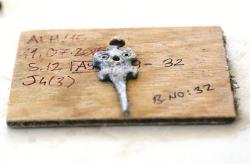 Alacahöyük - Excavations that have been continuing in Alacahöyük, one of the centers of Hittite civilization and considered Turkey’s first “national excavation field,” have unearthed nearly 3,700-year-old hair ties and jewelry made of animal horns. The head of the excavations, Professor Aykut Çınaroğlu, said they had found the hair ties during excavations in the chambers of the mine factory. “The four ties we found are made of bronze, copper and tin. The motifs on the ties are interesting. We estimate that the Hittite women used these ties to tie their hair in ponytails,” he said. Çınaroğlu said both the royal family members and the public had used the hair ties according to their estimations. He said the ties were produced in the factory. “Hittite people were proud of their beardless and clean face, but the Assyrians had beards. In my opinion, these ties were used by women. We know that the Hittite women used to wear earrings and necklaces. They would have been used by the public.” He said they had also found jewelry made of horns during an excavation in another field. “It has some motifs on it like an eye. It is nice jewelry. We don’t know what kind of horn it is. It was also used by the public. Such jewelry was used in the Hittite era. We can say that these people were fond of such things,” Çınaroğlu said, adding that works would continue and that they expected to find other important artifacts during the excavations in the factory and other fields.
Alacahöyük - Excavations that have been continuing in Alacahöyük, one of the centers of Hittite civilization and considered Turkey’s first “national excavation field,” have unearthed nearly 3,700-year-old hair ties and jewelry made of animal horns. The head of the excavations, Professor Aykut Çınaroğlu, said they had found the hair ties during excavations in the chambers of the mine factory. “The four ties we found are made of bronze, copper and tin. The motifs on the ties are interesting. We estimate that the Hittite women used these ties to tie their hair in ponytails,” he said. Çınaroğlu said both the royal family members and the public had used the hair ties according to their estimations. He said the ties were produced in the factory. “Hittite people were proud of their beardless and clean face, but the Assyrians had beards. In my opinion, these ties were used by women. We know that the Hittite women used to wear earrings and necklaces. They would have been used by the public.” He said they had also found jewelry made of horns during an excavation in another field. “It has some motifs on it like an eye. It is nice jewelry. We don’t know what kind of horn it is. It was also used by the public. Such jewelry was used in the Hittite era. We can say that these people were fond of such things,” Çınaroğlu said, adding that works would continue and that they expected to find other important artifacts during the excavations in the factory and other fields.
http://www.hurriyetdailynews.com/hittite-womens-hair-tie-discovered.aspx?pageID=238&nid=88240
ROYAUME UNI -  Blackburn - Experts exhuming human remains on the route of the new Freckleton Street link road have found the predicted number of graves – but several of them have multiple occupants. Blackburn with Darwen highways boss Councillor Phil Riley said the number of interments in the grounds of the old St Peter’s Church was around the 200 the council archaeologists forecast. But the number of sets of remains was significantly higher owing to repeat burials in the same graves.
Blackburn - Experts exhuming human remains on the route of the new Freckleton Street link road have found the predicted number of graves – but several of them have multiple occupants. Blackburn with Darwen highways boss Councillor Phil Riley said the number of interments in the grounds of the old St Peter’s Church was around the 200 the council archaeologists forecast. But the number of sets of remains was significantly higher owing to repeat burials in the same graves.
http://www.lancashiretelegraph.co.uk/news/13654928.Blackburn_link_road_graveyard_dig_reveals_multiple_burials_in_same_graves/
USA –  Yellowstone - The climate changes, history is emerging from the glaciers where it was preserved. But glaciers aren’t the only previously-frozen forms giving up their artifacts — even smaller ice patches contain discoveries. For Wyofile, Kelsey Dayton reports that in Yellowstone National Park, archeologists are racing to collect the emerging ice-encased trees, the bodies of animals and the ancient tools, spears and utensils that have been preserved high in the Rocky Mountains. Ice patches don’t move like the larger glaciers, so they are even better suited for preserving material. In the greater Yellowstone ecosystem — an area that includes surrounding mountains and forests — researchers started collecting these artifacts about eight years ago, Craig Lee, an archeologist at the Institute of Arctic Alpine Research in Colorado, told Dayton. In Yellowstone, Lee, archeologist Staffan Peterson, and others have found animal bones, wooden weapons, and other artifacts ranging from 10,000 year to just a few hundred years old. They've carbon-dated leaves and tree stumps that are more than 5,000 years old.
Yellowstone - The climate changes, history is emerging from the glaciers where it was preserved. But glaciers aren’t the only previously-frozen forms giving up their artifacts — even smaller ice patches contain discoveries. For Wyofile, Kelsey Dayton reports that in Yellowstone National Park, archeologists are racing to collect the emerging ice-encased trees, the bodies of animals and the ancient tools, spears and utensils that have been preserved high in the Rocky Mountains. Ice patches don’t move like the larger glaciers, so they are even better suited for preserving material. In the greater Yellowstone ecosystem — an area that includes surrounding mountains and forests — researchers started collecting these artifacts about eight years ago, Craig Lee, an archeologist at the Institute of Arctic Alpine Research in Colorado, told Dayton. In Yellowstone, Lee, archeologist Staffan Peterson, and others have found animal bones, wooden weapons, and other artifacts ranging from 10,000 year to just a few hundred years old. They've carbon-dated leaves and tree stumps that are more than 5,000 years old.
http://www.smithsonianmag.com/smart-news/melting-ice-yellowstone-revealing-ancient-artifacts-180956488/?no-ist
PEROU – 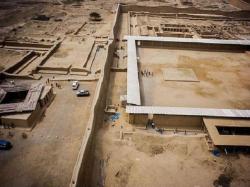 - El Niño is expected to hit Peru this year and have the greatest impact in decades. Warmer ocean temperatures are bringing heavier rains and higher land temperatures, and therefore, mudslides, flooding, displacement and archaeological destruction. archaeological sites are at great risk and for that reason the Ministry of Culture has been preparing since last year to protect its historical sites. They started preventative works in 63 emblematic archaeological sites in the north of Peru, where the adverse effects are expected to be the worse. They are working in the regions of Tumbes, Piura, Lambayeque, La Libertad and Ancash.
- El Niño is expected to hit Peru this year and have the greatest impact in decades. Warmer ocean temperatures are bringing heavier rains and higher land temperatures, and therefore, mudslides, flooding, displacement and archaeological destruction. archaeological sites are at great risk and for that reason the Ministry of Culture has been preparing since last year to protect its historical sites. They started preventative works in 63 emblematic archaeological sites in the north of Peru, where the adverse effects are expected to be the worse. They are working in the regions of Tumbes, Piura, Lambayeque, La Libertad and Ancash.
http://www.peruthisweek.com/news-nino-ministry-of-culture-working-in-63-archaeological-sites-107521
ROYAUME UNI – Dunwich - Signs of Neolithic life have been discovered by volunteer archaeologists probing the ground of a "lost" settlement in Suffolk. It was hoped medieval artefacts would be unearthed during the summer dig at Dunwich, so experts were excited by a find dating back to the Neolithic era. The dig, organised by Touching the Tide project, also found new evidence of an Anglo-Saxon settlement. A Neolithic scraper used on animal hides or wood was one of the discoveries, as well as many shards of Anglo-Saxon pottery.
http://www.bbc.co.uk/news/uk-england-suffolk-34197806
ITALIE – 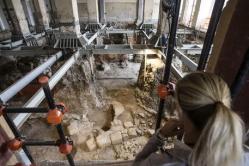 Rome - The remains of a 6th century BC dwelling have been found by archaeologists in central Rome, ANSA sources said on Wednesday. The sources said the find is extraordinary due to the good condition of the structure and the fact that the area was thought to host a necropolis. It was discovered during a dig at Palazzo Canevari on the Quirinal Hill, which also hosts the official residence of the Italian president.
Rome - The remains of a 6th century BC dwelling have been found by archaeologists in central Rome, ANSA sources said on Wednesday. The sources said the find is extraordinary due to the good condition of the structure and the fact that the area was thought to host a necropolis. It was discovered during a dig at Palazzo Canevari on the Quirinal Hill, which also hosts the official residence of the Italian president.
http://www.ansa.it/english/news/lifestyle/arts/2015/09/09/sixth-century-bc-dwelling-found-in-rome_488e2e60-a9d0-43d5-b850-cad359b59a7f.html?
IRAN – 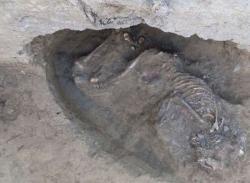 Lapouei hill - An archeologist said the body, found in the Lapouei hill, belongs to a 30- to 35-year-old man. Norouz Rajabi, leader of the excavation team in that area, told IRNA on Wednesday that the skeleton, way of burying it and how it had been placed in the soil give fruitful information of the history. Research on the diet he had and kind of his diseases can be done in future studies, said Rajabi. A village existing in the area goes back to 3,300 to 3,700 BC, said he. The excavation shows formation of a historical civilization in that area, said the archeologist. Lapouei hill is located 20 km north of Shiraz and 25 km south of Persepolis. Persepolis literally meaning 'city of Persians' was the ceremonial capital of the Achaemenid Empire.
Lapouei hill - An archeologist said the body, found in the Lapouei hill, belongs to a 30- to 35-year-old man. Norouz Rajabi, leader of the excavation team in that area, told IRNA on Wednesday that the skeleton, way of burying it and how it had been placed in the soil give fruitful information of the history. Research on the diet he had and kind of his diseases can be done in future studies, said Rajabi. A village existing in the area goes back to 3,300 to 3,700 BC, said he. The excavation shows formation of a historical civilization in that area, said the archeologist. Lapouei hill is located 20 km north of Shiraz and 25 km south of Persepolis. Persepolis literally meaning 'city of Persians' was the ceremonial capital of the Achaemenid Empire.
http://www.irna.ir/en/News/81753308/?
BULGARIE – 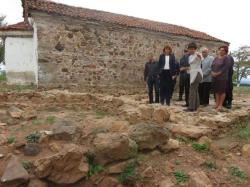 Buhovo - One of the largest Early Christian basilicas in Bulgaria, which is located in the Buhovo Monastery “St. Mary Magdalene” near the town of Buhovo in Sofia Municipality, to the northeast of Sofia’s mainurban area, has been completely unearthed, with the archaeologists also discovering a grave of aRoman citizen from the 4th century AD. The Early Christian basilica in the Buhovo Monastery dates back to the 4th-6th century AD, i.e. the Late Roman and Early Byzantine period, and is of impressive size – it is 41 meters long, and 27 meters wide at its widest section. According to archaeologist Snezhana Goryanova, the Late Roman and Early Byzantine basilica in Buhovo was a one-apse, three-nave basilica with a narthex, two accessory rooms, and a funeral room in its southeast corner where the archaeologists have found the grave of a Roman citizen who appears to have been important for the local Early Christian community. In the Roman man’s grave, the archaeologists have found a coin, the so called obol for Charon, the ferryman of Hades who, according to Ancient Thracian, Greek, and Roman mythology, carries the souls of the newly deceased across the rivers Styx and Acheron in the underworld. Other artifacts found in the 4th century AD Roman grave by the archaeologists include bracelets and crosses as well as fragments indicating that the basilica was covered with glazed tiles on the outside, and had murals on the inside.
Buhovo - One of the largest Early Christian basilicas in Bulgaria, which is located in the Buhovo Monastery “St. Mary Magdalene” near the town of Buhovo in Sofia Municipality, to the northeast of Sofia’s mainurban area, has been completely unearthed, with the archaeologists also discovering a grave of aRoman citizen from the 4th century AD. The Early Christian basilica in the Buhovo Monastery dates back to the 4th-6th century AD, i.e. the Late Roman and Early Byzantine period, and is of impressive size – it is 41 meters long, and 27 meters wide at its widest section. According to archaeologist Snezhana Goryanova, the Late Roman and Early Byzantine basilica in Buhovo was a one-apse, three-nave basilica with a narthex, two accessory rooms, and a funeral room in its southeast corner where the archaeologists have found the grave of a Roman citizen who appears to have been important for the local Early Christian community. In the Roman man’s grave, the archaeologists have found a coin, the so called obol for Charon, the ferryman of Hades who, according to Ancient Thracian, Greek, and Roman mythology, carries the souls of the newly deceased across the rivers Styx and Acheron in the underworld. Other artifacts found in the 4th century AD Roman grave by the archaeologists include bracelets and crosses as well as fragments indicating that the basilica was covered with glazed tiles on the outside, and had murals on the inside.
http://archaeologyinbulgaria.com/2015/09/08/archaeologists-unearth-large-early-christian-basilica-with-roman-grave-right-outside-of-bulgarias-capital-sofia/